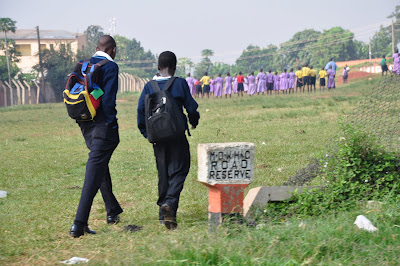

 Top: Solar Energy for Africa outpost close to the Equator in Uganda
Top: Solar Energy for Africa outpost close to the Equator in UgandaMiddle: Adorable boy playing with the papaya trees and dead branches by Living Goods branch outside Kampala
Bottom: Massive Tilapia on display for sale outside Kampala
On our last day in Kampala on the outskirts of the city, the car came to a dead stop due to a traffic jam. This is not unusual. I had become quite accustomed to dead stops for no reason other than congestion in a city built for 2 million, which is forced to accomodate 4 million commuters and an ever rapidly urbanizing population.
Today, however, the reason for idling was not just poor city planning. After about 10 minutes behind a massive dump truck, our throats slowly coating with dust, petrol and burning trash fumes tinged with bitter sweet perspiration, our driver Herbert, announced we would soon be enmeshed in a massive political rally. Mr. Peter Sematimba of the The National Resistance Movement (NRM) is campaigning for a critical seat in Kampala's Rubaga Division LC3.
As there is quiet before the storm, so there was calm before the onslaught of NRM-ers surging through the narrow two-lane street of this district. We waited with baited breath to determine the mood of the mob before rolling down the windows, keeping doors locked. A trickle of a crowd began to form on either side of us, waiting for the parade. Children crossed the street after school, calling out "Mazungu!" at us and posing for pictures. A few solitary motorcycles drove through the street 'decorated' with leafy branches ripped from trees. The men adorned with homemade head ornaments of palm and banana leaf. Some wore the bright yellow of the campaign colors or makeshift sandwich boards plastered with posters of Mr. Sematimba. Then, in full force, dillapidated cars, bulldozers, more motorcycles and pick-up trucks so overloaded with people that their rear axels' groaned under the weight came both careening and inching down the street, depending on the distance they maintained from the rest of the campaigners. Mostly, people were on foot fervently shouting, "OBAMA! OBAMA"!
This confused me completely, "who are they campaigning for?", I asked. Herbert answered that they liken Mr. Sematimba to the "Obama of Uganda". This may seem weighty to some, but all you need to do is hang out in east Africa for a bit to know the pride, proximity and/or reference to the new American President (any way you can get it) wins points. So, with some context, check out the video below!
Ignore my ridiculous narration of the event as Herbert mistakenly pointed out Sematimba three times, which I announce, only to discover it was never him. He passes by standing at the very top of the bulldozer, out of the camera's reach.
'Til next time!
Hilaria
















